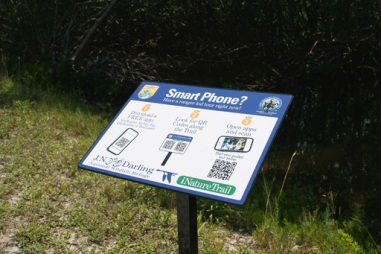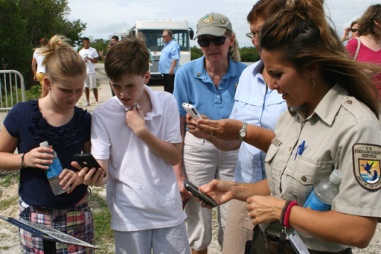QR Codes Helping Us Get Back to Nature?
 Part of the hype about QR codes (those black and white square bar codes you can scan with an app on your phone, and be taken to a website, video, or other digital treat) is the fact that they provide a simple and convenient link between the physical and the digital. For example, you can scan a QR code in a magazine and be taken to an online promotion on your phone.
Part of the hype about QR codes (those black and white square bar codes you can scan with an app on your phone, and be taken to a website, video, or other digital treat) is the fact that they provide a simple and convenient link between the physical and the digital. For example, you can scan a QR code in a magazine and be taken to an online promotion on your phone.
J.N. “Ding” Darling National Wildlife Refuge (NWR) on Florida’s Gulf Coast Sanibel Island, is taking the idea to a new level, by linking nature itself to the virtual world. Realizing that telling people to “turn off their phones and enjoy nature” does not always work very well, the nature reserve is engaging techies and the younger generation on their own terms.
Visitors to the park (averaging 800,000 a year) can walk, bike, or drive around the iNature trail and easily spot a series of 10 signs that feature QR codes. Some of the codes are geared for adults and the others for kids. Anyone with a Smartphone and a QR scanning app (of which there are numerous options for free download), can scan the app and be virtually guided through the park.
The QR codes link visitors to a variety of informative materials that allow people to interact with nature in a whole new way. Some of the QR codes link to short YouTube videos, such as a welcome message by the Refugee Manager, instructions on how to plant a mangrove tree, or informational clips about alligators, ospreys, or other animals. Other QR codes link to educational websites that let people discover more about the animals and plants around them.
“This is the first such interactive trail in the 550-plus national wildlife refuges,” said Supervisory Refuge Ranger Toni Westland. Westland says they  are “moving into the mobile world to educate thousands of people about wildlife and its protection in a whole new way.”
are “moving into the mobile world to educate thousands of people about wildlife and its protection in a whole new way.”
The new QR codes appeal not only to technology lovers, but to nature lovers as well, since they allow the refuge to reduce the paper wasted on brochures.
The idea for the iNature trail came from Lars Bredahl, who grew up on Sanibel and had an inspiration to create the trail codes for a student project at Elon University. Completing the project in less than 6 months, finding a local videographer to voluntarily help film the videos, and obtaining private contributions to pay for the signs through the “Ding” Darling Wildlife Society-Friends of the Refuge made this project an inexpensive way to give the refuge a whole new appeal.
When asked about how people were responding to the new QR-powered iNature trail, Westland says, "It was a fun, new, innovative project that I thought would be a hit. But I never really knew the hype until I saw it in action. Techy kids of ALL ages are really enjoying being able to use their smart phones to learn more. I've seen the 'spark' in their eyes as they jump from the vehicle to use their phone to learn more. I think they like that we are embracing their online passion instead of telling them to turn it off!"
In a noble mission to increase public and education and awareness about conservation of American wildlife and habitat, the Refuge has demonstrated a willingness to reach out to our technology-driven society, and give us a chance to learn about, appreciate, and interact with nature in a creative new way.
Related articles:
QR Codes Collect Customer Feedback for Canada Post
QR Pal Makes Scanning, Storing, and Sharing Codes Easy and Fun
QRaffiticodes.com helps business owners launch QR code campaigns
{jcomments on}
